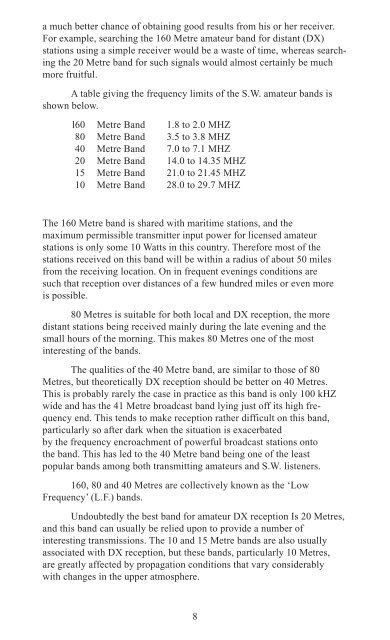Solid State Shortwave Receivers For Beginners - The Listeners Guide
Solid State Shortwave Receivers For Beginners - The Listeners Guide
Solid State Shortwave Receivers For Beginners - The Listeners Guide
Create successful ePaper yourself
Turn your PDF publications into a flip-book with our unique Google optimized e-Paper software.
a much better chance of obtaining good results from his or her receiver.<br />
<strong>For</strong> example, searching the 160 Metre amateur band for distant (DX)<br />
stations using a simple receiver would be a waste of time, whereas searching<br />
the 20 Metre band for such signals would almost certainly be much<br />
more fruitful.<br />
A table giving the frequency limits of the S.W. amateur bands is<br />
shown below.<br />
l60 Metre Band 1.8 to 2.0 MHZ<br />
80 Metre Band 3.5 to 3.8 MHZ<br />
40 Metre Band 7.0 to 7.1 MHZ<br />
20 Metre Band 14.0 to 14.35 MHZ<br />
15 Metre Band 21.0 to 21.45 MHZ<br />
10 Metre Band 28.0 to 29.7 MHZ<br />
<strong>The</strong> 160 Metre band is shared with maritime stations, and the<br />
maximum permissible transmitter input power for licensed amateur<br />
stations is only some 10 Watts in this country. <strong>The</strong>refore most of the<br />
stations received on this band will be within a radius of about 50 miles<br />
from the receiving location. On in frequent evenings conditions are<br />
such that reception over distances of a few hundred miles or even more<br />
is possible.<br />
80 Metres is suitable for both local and DX reception, the more<br />
distant stations being received mainly during the late evening and the<br />
small hours of the morning. This makes 80 Metres one of the most<br />
interesting of the bands.<br />
<strong>The</strong> qualities of the 40 Metre band, are similar to those of 80<br />
Metres, but theoretically DX reception should be better on 40 Metres.<br />
This is probably rarely the case in practice as this band is only 100 kHZ<br />
wide and has the 41 Metre broadcast band lying just off its high frequency<br />
end. This tends to make reception rather difficult on this band,<br />
particularly so after dark when the situation is exacerbated<br />
by the frequency encroachment of powerful broadcast stations onto<br />
the band. This has led to the 40 Metre band being one of the least<br />
popular bands among both transmitting amateurs and S.W. listeners.<br />
160, 80 and 40 Metres are collectively known as the ‘Low<br />
Frequency’ (L.F.) bands.<br />
Undoubtedly the best band for amateur DX reception Is 20 Metres,<br />
and this band can usually be relied upon to provide a number of<br />
interesting transmissions. <strong>The</strong> 10 and 15 Metre bands are also usually<br />
associated with DX reception, but these bands, particularly 10 Metres,<br />
are greatly affected by propagation conditions that vary considerably<br />
with changes in the upper atmosphere.<br />
8

















